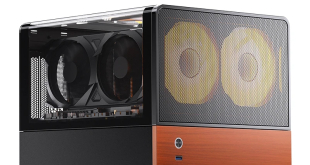The Thermaltake Chaser A31 is an eye-catching case with some unique features that will appeal to a gaming audience.
Designed for housing mid-range ATX hardware, working inside the Chaser A31's confined interior is likely to increase build time. We managed to fit a large CPU cooler, hefty power supply and mid-range graphics card inside the Chaser A31, but this did cause a few inconvenient interference issues, especially with fan mounts. Additional graphics cards are a possibility, but larger CPU coolers or power supplies will only increase the interference headaches.
While we do expect some unavoidable interference issues in mid-tower cases, leaving 23mm of clearance above a motherboard to mount 25mm-thick fans is a questionable design choice. An extra few millimetres would have had a negligible effect on cost but they would have reduced the interference possibilities of real world performance oriented gaming builds, most of which will use a large CPU cooler.
On the topic of cooling, the only way that a 240/280mm AIO watercooling unit will mount in the Chaser A31 without causing major interference problems, is by having the fans positioned beneath the top panel. Perhaps with low profile memory and short VRM heatsinks an AIO unit will be able to fit internally by overlapping the motherboard's upper edge without being blocked. It is not ideal however.
The Chaser A31's cable management routes are generally good. Three grommets located in close proximity to the power supply and motherboard's right edge make routing cables to the rear side a simple task. The 8-pin cut-out could use a size increase and a clear route for front panel and audio connections would be beneficial.
With a maximum of just 19 millimetres of clearance directly behind the motherboard tray, it's hard not to feel like the good cable routing system is somewhat wasted. Securing the door over a fat 24-pin cable, PCI-E connectors and SATA leads requires a large amount of muscle. Add another graphics card or more hard drives and the cable management difficulty is only going to increase. An extra 5-10mm of space behind the motherboard tray would have eliminated most of the clearance issues.
Expansion options for Thermaltake's Chaser A31 users are good. Six 2.5/3.5″ storage drive bays are plenty for a clear majority of gamers and mid-range users. Three 5.25″ mounts, one of which can covert to an external 3.5″ bay, is also a good number. Clearance for large graphics cards, power supplies and CPU coolers extends the Chaser A31's expansion flexibility.
Thermaltake has done a very good job of designing the Chaser A31 with an eye-catching design that will appeal to gamers. The front panel's blue accents are a great design feature, as is the general non-linear style. Some people may be put off by the widespread use of plastic, but Thermaltake actually does an admirable job of making it sturdy and good-looking.
At £79.99 from OverclockersUK, the Thermaltake Chaser A31 is situated in a cut-throat segment of the market. Given that cases such as the NZXT Phantom 410, Fractal Design R4, Corsair 400R, and Cooler Master CM690 are all priced within a few pounds of Thermaltake's model, the Chaser A31 is going to have a tough time competing without any type of price reduction.
Pros:
- Eye-catching gamer design.
- Quiet fans.
- Large side panel window.
- Holding area for portable devices.
- Good GPU, CPU cooler and power supply clearance.
Cons:
- No fan controller.
- Limited cable management clearance.
- PCI slots not tool-less.
- Layout can causes interference, mainly with fan mounts.
- Some cost-cutting build decisions – no rubber dampers, plastic feet, short audio cable.
- Priced too closely to very tough competitors.
KitGuru says: An eye-catching, gamer-orientated chassis with room for large components, but it is not good enough to compete with similarly-priced options.
 KitGuru KitGuru.net – Tech News | Hardware News | Hardware Reviews | IOS | Mobile | Gaming | Graphics Cards
KitGuru KitGuru.net – Tech News | Hardware News | Hardware Reviews | IOS | Mobile | Gaming | Graphics Cards



My friend had one of these cases and it literally fell apart. he sent a complaint to TT and never had a reply. avoid
Well I havent owned this one, but I did buy a similar case from thermaltake and the fans were so loud I had to disconnec them. they have very slow standards, and I prefer CoolerMastrer now.
So you compare a case at around £80 against one at £130. Credibility all gone.